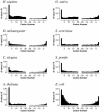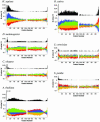Comparative analysis of the base biases at the gene terminal portions in seven eukaryote genomes
- PMID: 12930971
- PMCID: PMC212801
- DOI: 10.1093/nar/gkg701
Comparative analysis of the base biases at the gene terminal portions in seven eukaryote genomes
Abstract
Adenine nucleotides have been found to appear preferentially in the regions after the initiation codons or before the termination codons of bacterial genes. Our previous experiments showed that AAA and AAT, the two most frequent second codons in Escherichia coli, significantly enhance translation efficiency. To determine whether such a characteristic feature of base frequencies exists in eukaryote genes, we performed a comparative analysis of the base biases at the gene terminal portions using the proteomes of seven eukaryotes. Here we show that the base appearance at the codon third positions of gene terminal regions is highly biased in eukaryote genomes, although the codon third positions are almost free from amino acid preference. The bias changes depending on its position in a gene, and is characteristic of each species. We also found that bias is most outstanding at the second codon, the codon after the initiation codon. NCN is preferred in every genome; in particular, GCG is strongly favored in human and plant genes. The presence of the bias implies that the base sequences at the second codon affect translation efficiency in eukaryotes as well as bacteria.
Figures



Similar articles
-
Regularities of context-dependent codon bias in eukaryotic genes.Nucleic Acids Res. 2002 Mar 1;30(5):1192-7. doi: 10.1093/nar/30.5.1192. Nucleic Acids Res. 2002. PMID: 11861911 Free PMC article.
-
Codon usage bias is correlated with gene expression levels in the fission yeast Schizosaccharomyces pombe.Genes Cells. 2009 Apr;14(4):499-509. doi: 10.1111/j.1365-2443.2009.01284.x. Genes Cells. 2009. PMID: 19335619
-
Codon usage and tRNA genes in eukaryotes: correlation of codon usage diversity with translation efficiency and with CG-dinucleotide usage as assessed by multivariate analysis.J Mol Evol. 2001 Oct-Nov;53(4-5):290-8. doi: 10.1007/s002390010219. J Mol Evol. 2001. PMID: 11675589
-
Codon usage patterns in Escherichia coli, Bacillus subtilis, Saccharomyces cerevisiae, Schizosaccharomyces pombe, Drosophila melanogaster and Homo sapiens; a review of the considerable within-species diversity.Nucleic Acids Res. 1988 Sep 12;16(17):8207-11. doi: 10.1093/nar/16.17.8207. Nucleic Acids Res. 1988. PMID: 3138659 Free PMC article. Review.
-
DNA sequence evolution: the sounds of silence.Philos Trans R Soc Lond B Biol Sci. 1995 Sep 29;349(1329):241-7. doi: 10.1098/rstb.1995.0108. Philos Trans R Soc Lond B Biol Sci. 1995. PMID: 8577834 Review.
Cited by
-
Spatial analyses of mono, di and trinucleotide trends in plant genes.PLoS One. 2011;6(8):e22855. doi: 10.1371/journal.pone.0022855. Epub 2011 Aug 1. PLoS One. 2011. PMID: 21829660 Free PMC article.
-
Lso2 is a conserved ribosome-bound protein required for translational recovery in yeast.PLoS Biol. 2018 Sep 12;16(9):e2005903. doi: 10.1371/journal.pbio.2005903. eCollection 2018 Sep. PLoS Biol. 2018. PMID: 30208026 Free PMC article.
-
Amino acid biases in the N- and C-termini of proteins are evolutionarily conserved and are conserved between functionally related proteins.Protein J. 2008 Aug;27(5):283-91. doi: 10.1007/s10930-008-9136-1. Protein J. 2008. PMID: 18478318
-
C-terminal motif prediction in eukaryotic proteomes using comparative genomics and statistical over-representation across protein families.BMC Genomics. 2007 Jun 26;8:191. doi: 10.1186/1471-2164-8-191. BMC Genomics. 2007. PMID: 17594486 Free PMC article.
-
Comparative genomic analysis of translation initiation mechanisms for genes lacking the Shine-Dalgarno sequence in prokaryotes.Nucleic Acids Res. 2017 Apr 20;45(7):3922-3931. doi: 10.1093/nar/gkx124. Nucleic Acids Res. 2017. PMID: 28334743 Free PMC article.
References
-
- Sato T., Terabe,M., Watanabe,H., Gojobori,T., Hori-Takemoto,C. and Miura,K. (2001) Codon and base biases after the initiation codon of the open reading frames in the Escherichia coli genome and their influence on the translation efficiency. J. Biochem., 129, 851–860. - PubMed
-
- Stenström C.M., Jin,H., Major,L.L., Tate,W.P. and Isaksson,L.A. (2001) Codon bias at the 3′-side of the initiation codon is correlated with translation initiation efficiency in Escherichia coli. Gene, 263, 273–284. - PubMed
Publication types
MeSH terms
Substances
LinkOut - more resources
Full Text Sources
Molecular Biology Databases
Research Materials
Miscellaneous

